
Eucalyptus porosa, commonly known as mallee box, Quorn mallee or water mallee, is a species of mallee or a tree that is endemic to southern Australia. It has rough, fibrous or flaky bark on the trunk and larger branches, smooth greyish bark above, lance-shaped adult leaves, flower buds in groups of seven, white flowers and barrel-shaped or shortened spherical fruit.

Eucalyptus albopurpurea, commonly known as the purple-flowered mallee box or Port Lincoln mallee, is a mallee or sometimes a tree that is endemic to South Australia. It has loose, fibrous grey-brown bark on the lower park of the trunk and smooth grey bark that is shed in strips on its upper parts. The leaves are lance-shaped to egg-shaped, the flower buds are spindle-shaped to club-shaped and the flowers are white, pink, mauve or purple. Flowering can occur in most months and the fruit are cup-shaped or barrel-shaped capsules.

Eucalyptus intertexta, commonly known as inland red box, western red box, gum coolibah or the bastard coolibah, is a species of tree that is endemic to central Australia. It has rough, fibrous or flaky bark on the base of the trunk, smooth white to brownish bark above, lance-shaped adult leaves, flower buds in groups of seven on the ends of branchlets, white flowers and cup-shaped to hemispherical fruit.
Eucalyptus glomerosa, commonly known as jinjulu, is a species of mallee that is endemic to inland Australia. It has rough, fibrous and flaky bark near the base, smooth bark above, egg-shaped to lance-shaped adult leaves, flower buds usually in groups of seven, cream-coloured flowers and conical to hemispherical fruit. It is mainly found in the Great Victoria Desert of South Australia but also grows in eastern parts of Western Australia.

Eucalyptus mannensis, commonly known as Mann Range mallee, is a species of mallee that is native to Western Australia, South Australian and the Northern Territory. It has rough bark at the base of the trunk, smooth bark above, narrow lance-shaped adult leaves, flower buds in groups of between seven and eleven, creamy white flowers and hemispherical fruit.
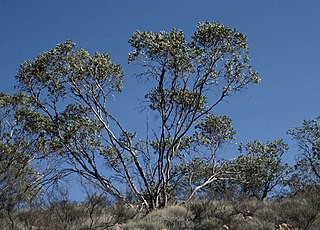
Eucalyptus oxymitra, commonly known as the sharp-capped mallee, is a species of mallee that is endemic to remote parts of Central Australia. It has rough bark on the trunk, smooth greyish bark above, lance-shaped to egg-shaped adult leaves, flower buds in groups of seven, white to pale yellow flowers and hemispherical fruit.

Eucalyptus rugosa, commonly known as the Kingscote mallee, is a species of mallee that is endemic to coastal areas of southern Western Australia and South Australia. It has smooth bark, lance-shaped adult leaves, flower buds in groups of between seven and thirteen, white flowers and cup-shaped, conical or hemispherical fruit.
Eucalyptus semota, commonly known as marymia mallee, is a species of mallee or small tree that is endemic to a small area in central Western Australia. It has rough, flaky to fibrous bark on the trunk, smooth grey or brown bark above, linear to narrow lance-shaped leaves, flower buds in groups of seven or nine, white flowers and conical to cup-shaped fruit.

Eucalyptus sparsa, commonly known as the northern ranges box, is a species of mallee that is endemic to inland Australia, near the border between the Northern Territory, South Australia and Western Australia border. It has smooth pale grey and brown bark, often with rough bark on the base of larger trunks, lance-shaped adult leaves, flower buds usually in groups of seven, white flowers and shortened spherical to conical fruit.

Eucalyptus striaticalyx, commonly known as Cue York gum or kopi gum, is a species of tree or mallee that is endemic to Western Australia. It has thick, rough, fibrous bark on the trunk and larger branches, lance-shaped adult leaves, flower buds in groups of between seven and thirteen, creamy white flowers and conical to cup-shaped fruit.
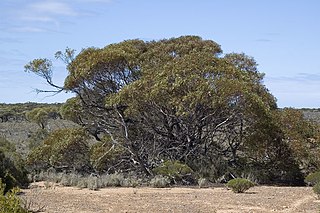
Eucalyptus yalatensis, commonly known as the Yalata mallee, is a species of mallee or a shrub that is endemic to southern Australia. It has rough, fibrous or flaky bark on the stems, smooth bark above, lance-shaped adult leaves, flower buds mostly in groups of nine, creamy white or yellowish flowers and hemispherical to shortened spherical fruit.
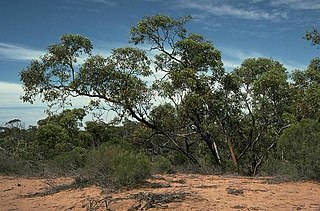
Eucalyptus yumbarrana, commonly known as the Yumbarra mallee is a species of mallee that is endemic to South Australia. It has rough, flaky bark on the lower trunk, smooth bark above, egg-shaped to lance-shaped adult leaves, flower buds in groups of seven, creamy white to yellow flowers and shortened spherical to cup-shaped fruit.

Eucalyptus arenacea, commonly known as the desert stringybark or sand stringybark, is a tree or a mallee that is endemic to south-eastern Australia. It has rough bark to the thinnest branches, lance-shaped or curved adult leaves, club-shaped flower buds arranged in groups of between seven and fifteen, white flowers and hemispherical to more or less spherical fruit.

Eucalyptus bakeri, commonly known as Baker's mallee or the mallee box, is a eucalypt that is endemic to eastern Australia. It has fibrous bark on the trunk and smooth white or grey bark above, narrow lance-shaped leaves, flower buds in groups of between seven and thirteen, white flowers and hemispherical or shortened spherical fruit.
Eucalyptus tephrodes is a species of small tree or mallee that is endemic to Western Australia. It has rough bark on the trunk and larger branches, smooth bark above, egg-shaped to lance-shaped adult leaves, flower buds in groups of three on the ends of branchlets and cup-shaped to hemispherical fruit.
Eucalyptus longissima is a species of mallee or small tree that is endemic to the south-west of Western Australia. It has rough, fibrous or stringy bark on the trunk, smooth greyish brown bark above, glossy green, lance-shaped adult leaves, flower buds in group of between seven and thirteen, white flowers and shortened spherical fruit.

Eucalyptus socialis subsp. eucentrica, commonly known as the inland red mallee, is a subspecies of mallee that is endemic to inland Australia. It usually has rough bark on the base of the trunk, smooth bark above, lance-shaped adult leaves, flower buds in groups of between seven and eleven, pale creamy yellow flowers and barrel-shaped to urn-shaped or spherical fruit.
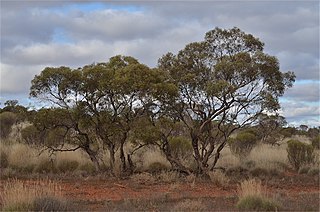
Eucalyptus socialis subsp. socialis, commonly known as the summer red mallee, is a subspecies of mallee that is endemic to inland south-eastern Australia. It usually has rough bark on the base of the trunk, smooth bark above, lance-shaped adult leaves, flower buds in groups of between seven and eleven, pale creamy white flowers and barrel-shaped to urn-shaped or spherical fruit.
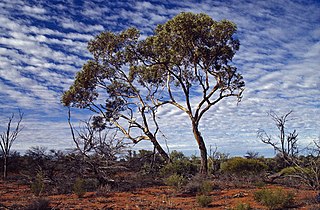
Eucalyptus socialis subsp. victoriensis, commonly known as the red mallee, is a subspecies of mallee that is endemic to southern inland Australia. It usually has rough bark on the base of the trunk, smooth bark above, lance-shaped adult leaves, flower buds in groups of between seven and eleven, pale creamy yellow flowers and barrel-shaped to urn-shaped or spherical fruit.
Eucalyptus socialis subsp. viridans, commonly known as the green-leaved red mallee, is a subspecies of mallee that is endemic to south-eastern Australia. It usually has rough bark on the base of the trunk, smooth bark above, lance-shaped adult leaves, flower buds in groups of between seven and eleven, pale creamy yellow flowers and barrel-shaped to urn-shaped or spherical fruit.














